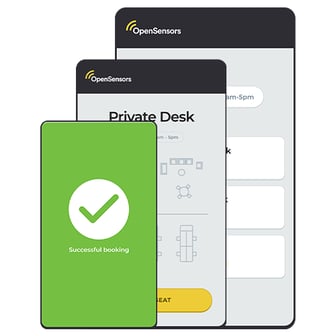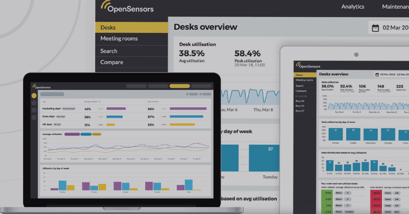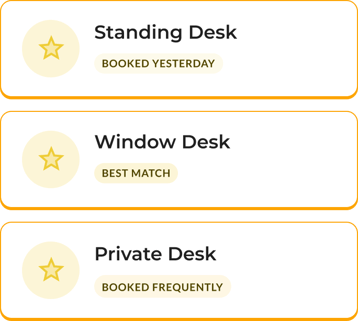Here’s how our intelligent booking tool can mitigate the space and administrative challenges organisations and their employees face when introducing and managing hybrid work.
Hybrid workplaces - what’s different?
The way in which we interact with office space has changed as organisations transition to hybrid working. We have been assisting clients around the globe adapt their workplaces to the post-COVID19 era, and have identified trends in workplace design and strategy across multiple sectors, along with the challenges that these changes bring.
In hybrid workplaces, many employees elect to divide their time between the office and their homes, resulting in significant office space being converted into bookable and shared workstations. Additionally, more collaboration and meeting spaces are required as employees look to fully utilise their limited time within the office.
Challenges in managing hybrid spaces
As a result of employees sharing spaces and following less regular working schedules, new organisational and spatial challenges have emerged. Teams need to ensure that employees are provided with the correct array of workplace assets, and are able to access them quickly and easily.
Clearly, new booking tools are required to manage the workplace.
A booking tool for the hybrid age

Over the past 18 months we have developed an intelligent booking tool to help manage hybrid offices.
It is designed to solve the challenges of the teams responsible for the workplace and the employees within it.
1. Maintaining a safe working environment
As organisations navigate periods of relative uncertainty, with new governmental regulations being introduced to mitigate the risk of COVID19 variants, it is vital that the workplace is able to flex rapidly to accommodate varying levels of occupancy in a safe and controlled manner.
2. Using booking tools to manage social distancing
A primary concern for teams managing the workplace over the past 18 months has been ensuring that capacity is not exceeded and individuals have the necessary space within the workplace to remain safe from viral transmission.
Teams have been relying on physically cordoning off individual desks or entire areas of the building, and as guidelines have changed this became an increasingly arduous task. By introducing a booking tool to act as a central point of access to the workplace the teams responsible for ensuring social distancing guidelines are adhered to are able to quickly and easily remove assets from the system should there be a reduction in capacity limits.
Furthermore, by making only the assets which are appropriately spaced available to be booked, teams can ensure that employees are working in a safe environment without having to change the physical layout of the workplace, creating a system which is highly flexible and ready to adapt.
3. Track and trace
We have seen organisations without a centralised booking solution rely on team managers reporting to FM teams a week in advance who will be coming to the office on which days, using email and excel to ensure capacity does not exceed set limits and run track and trace protocols.
Not only does collating data from every team create an enormous administrative burden, it is an inaccurate and inefficient methodology; where employee health and safety is concerned there is no space for guesswork.
Our
intelligent booking solution removes this challenge, enabling organisations to dynamically manage occupancy levels dependent on local guidelines, whilst providing teams with comprehensive data on capacity which can be easily accessed in the case of a viral breakout. Employees can enter the office safe in the knowledge that the necessary systems to safeguard their wellbeing are in place.
How our intelligent booking tool supports space management during uncertainty

1. Automatic check in and out
We have removed the need for employees to complete the repetitive and easily overlooked task of checking in and out of booked spaces by integrating occupancy sensors into our booking tool.
2. Sensor driven
Heat and motion sensors detect when a space is in use and confirm that the booking has been honoured. Similarly, in the case of no-shows, sensor integration enables previously booked spaces to be released into the system after no presence has been detected.
This means that the maximum amount of free space is readily available for employees to use, helping to optimise workplace efficiency and reduce waste. Automating these processes reduces the daily operational burden placed on employees simply seeking to access the office, making coming to work as quick and simple a process as possible.
3. Accurate data gathering
Not only does this functionality help to ensure that the workplace is used appropriately, but it provides Facilities and Workplace teams with critical information regarding employee behaviour within the office, enabling them to fine tune policies regarding office access.
Combining
booking data with actual utilisation data gathered from the sensors further enables teams to understand what their organisation’s ideal workplace is and make the appropriate changes based on employee behaviours.
4. Access made easy

Hybrid environments rely on there being as few obstacles as possible when accessing space. If it is not a seamless experience, frustration will grow.
To mitigate this risk the process of booking spaces needs to be quick and easy. We have a double-edged approach to this challenge:
- Employees have the ability to save their preferred locations, removing the need to search for spaces each time they venture in to work.
- Our solution learns from previous bookings and suggests similar spaces to those accessed previously, so even if your ideal spot is taken you can find one like it.
Want to learn more?
Find out more on how our intelligent booking solution can support your organisation with managing hybrid working and improve employee office experience.




 Hybrid environments rely on there being as few obstacles as possible when accessing space. If it is not a seamless experience, frustration will grow.
Hybrid environments rely on there being as few obstacles as possible when accessing space. If it is not a seamless experience, frustration will grow.